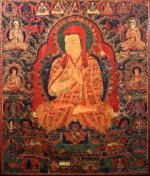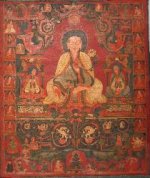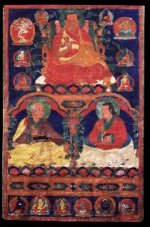
 Sonam Tsemo (bsod nams rtse mo) was born in 1142. His father was the Sakya patriarch Sachen Kunga Nyingpo (sa chen kun dga' snying po, 10920-1158). His mother was called Machik Wodron (ma gcig 'od sgron, d.u.). Like his father he remained a layman throughout his life, although he never married or had children. He was identified as the reincarnation of the Indian scholar Durgachandra (or Durjayachandra) who was the master of Viravajra. In turn, Viravajra was the teacher of Drokmi Śākya Yeshe ('brog mi lotsawa shakya ye shes, 992-1070).
Sonam Tsemo (bsod nams rtse mo) was born in 1142. His father was the Sakya patriarch Sachen Kunga Nyingpo (sa chen kun dga' snying po, 10920-1158). His mother was called Machik Wodron (ma gcig 'od sgron, d.u.). Like his father he remained a layman throughout his life, although he never married or had children. He was identified as the reincarnation of the Indian scholar Durgachandra (or Durjayachandra) who was the master of Viravajra. In turn, Viravajra was the teacher of Drokmi Śākya Yeshe ('brog mi lotsawa shakya ye shes, 992-1070).
During his childhood, Sonam Tsemo's main teacher was his father Sachen Kunga Nyingpo (kun dga' snying po, 1092-1158). His studies with his father focused on esoteric topics, and it is said that he could recite fourteen esoteric scriptures, including the Hevajra and Samvara tantras by the age of sixteen. He received oral Lamdre (lam 'bras) instructions from Sachen during this time. After Sachen passed away, Sonam Tsemo's education was strongly inflected by the Indian monastic model. At seventeen he went to the Kadampa monastery Sangpu Neutog (gsang phu ne'u thog) to study Madhyamaka philosophy and epistemology with the great master Chapa Chokyi Sengge (phya pa chos kyi seng ge, 1109-1169). This teacher had disciples from several of the most prominent families in U-Tsang. Sonam Tsemo's biography claims that he became the most accomplished of all the students. He studied with this master on and off for eleven years and became well versed in Mahāyāna texts such as Pramanaviniscaya and Bodhicharyavatara. Sonam Tsemo also received some instruction from the Indian or Nepali Acarya Sri Anandagharba.

 Sonam Tsemo's work Chola jugpai go (chos la ‘jug pa'i sgo), which he composed at the age of twenty-six at Nalatse, was extremely influential on the work of his nephew Sakya Paṇḍita Kunga Gyeltsen (sa skya paN+Di ta kun dga' rgyal mtshan, 1192-1251), the fourth Sakya patriarch and a widely renowned scholar. Sonam Tsemo's written works address topics including the Bodhicharyavatara, a schematization of the tantra; an explanation of the last two chapters of the Hevajra root tantra; a commentary on the Samputa tantra; instructions for reading Sanskrit, and commemorative texts for his main teachers.
Sonam Tsemo's work Chola jugpai go (chos la ‘jug pa'i sgo), which he composed at the age of twenty-six at Nalatse, was extremely influential on the work of his nephew Sakya Paṇḍita Kunga Gyeltsen (sa skya paN+Di ta kun dga' rgyal mtshan, 1192-1251), the fourth Sakya patriarch and a widely renowned scholar. Sonam Tsemo's written works address topics including the Bodhicharyavatara, a schematization of the tantra; an explanation of the last two chapters of the Hevajra root tantra; a commentary on the Samputa tantra; instructions for reading Sanskrit, and commemorative texts for his main teachers.
Sonam Tsemo first gave the Lamdre teachings in Sakya at the age of twenty-eight. Many famous masters attended the teaching, and he became renowned as a clear and skilled teacher, but his biographical data reflect a career more focused on study, practice and composition of texts than on teaching. His few close disciples included his brother Drakpa Gyeltsen (rje btsun grags pa rgyal mtshan, 1147-1216), Ngodrup (dngos grub, d.u.), Chagkyi Dorje (lcags kyi rdo rje, d.u.), and Tsugtor (gstug tor, d.u.). He was the active Sakya throne holder for only three years, after which he passed the responsibility on to his younger brother Drakpa Gyeltsen (grags pa rgyal mtshan, 1147-1216), in order to devote the rest of his life to study and retreat.
Sonam Tsemo passed away in 1182 at the age of forty. The details of his death are unclear, but it is recorded that his body disappeared and he left nothing but his robe and a footprint behind.
Images
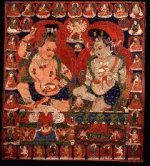
Damarupa
Damarupa and Avadhutipa, two Indian Siddhas. On the left is the siddha Damarupa holding upraised in his right hand a damaru drum and a skullcup in the left. On the viewer's right is Avadhutipa holding a skullcup to the heart with the left hand and pointing downwards with the right hand.
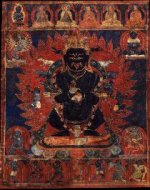
Mahakala - Panjarnata
Mahakala surrounded by the stylized flames of pristine awareness and emanating forth from the licks of flame are messengers in the shapes of various animals, black crows, black dogs, wolves, black men and women.
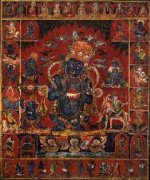
Mahākāla Pañjarnātha
Mahākāla Pañjarnātha, or "Lord of the Tent," is the protector of the Hevajra cycle of tantras. The iconography and rituals are found in the eighteenth chapter of the Vajra Pañjara Tantra, an exclusive 'explanatory tantra' to Hevajra itself. It is dated to the late fourteenth or early fifteenth century.
Bibliography
Davidson, Ronald. 2005. Tibetan Renaissance. New York: Columbia University Press.
Drakpa Jungne and Lobzang Kedrup. 1992. Gangs can mkhas grub rim byon ming dzod. kan su'u mi rigs skrun khang
Gold, Jonathan. 2008. The Dharma's Gatekeepers: Sakya Paṇḍita on Buddhist Scholarship in Tibet. Albany: State University of New York Press.
Roerich, George, trans. 1976. The Blue Annals. Delhi: Motilal Banarsidas
Sakyapa Ngawang Kunga Sonam. 2000. Holy Biographies of the Great Founders of the Glorious Sakya Order. Lama Kalsang Gyeltsen, Ani Kunga Chodron, and Victoria Huckenpahler, trans and eds. Silver Spring, MD: Sakya Puntsok Ling Publications.
Stearns, Cyrus. 2001. Luminous Lives: The Story of the Early Masters of the Lam 'bras Tradition in Tibet. Boston: Wisdom Publications.
Stearns, Cyrus. 2006. Taking the Path as the Result: Core Teachings of the Sakya Lamdre Tradition. Boston: Wisdom Publications.
